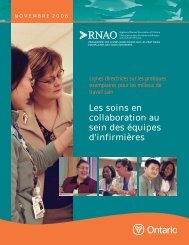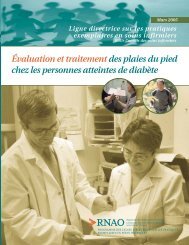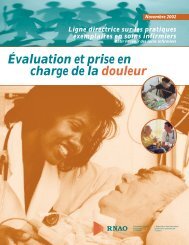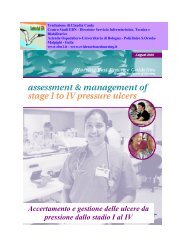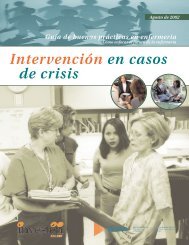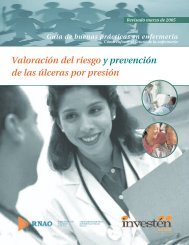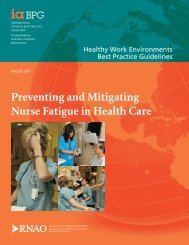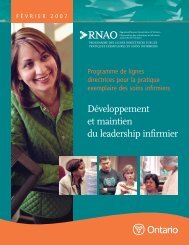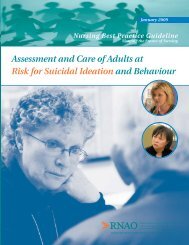Reducing Foot Complications for People with Diabetes - Registered ...
Reducing Foot Complications for People with Diabetes - Registered ...
Reducing Foot Complications for People with Diabetes - Registered ...
You also want an ePaper? Increase the reach of your titles
YUMPU automatically turns print PDFs into web optimized ePapers that Google loves.
<strong>Reducing</strong> <strong>Foot</strong> <strong>Complications</strong> <strong>for</strong> <strong>People</strong> <strong>with</strong> <strong>Diabetes</strong><br />
36<br />
Recommendation • 14.0<br />
Organizations should advocate <strong>for</strong> strategies and funding to assist clients to obtain<br />
appropriate footwear and specialized diabetes education. For example, the inclusion of<br />
funding support through the Assistive Devices Program (ADP) <strong>for</strong> appropriate footwear<br />
and orthotics. (Level IV)<br />
Recommendation • 15.0<br />
Organizations should advocate <strong>for</strong> an increase in the availability and accessibility of<br />
diabetes care and education services <strong>for</strong> all residents of Ontario. (Level IV)<br />
Recommendation • 16.0<br />
Nursing best practice guidelines can be successfully implemented only where there are<br />
adequate planning, resources, organizational and administrative support, as well as<br />
appropriate facilitation. Organizations may wish to develop a plan <strong>for</strong> implementation<br />
that includes:<br />
An assessment of organizational readiness and barriers to education.<br />
Involvement of all members (whether in a direct or indirect supportive function) who<br />
will contribute to the implementation process.<br />
Dedication of a qualified individual to provide the support needed <strong>for</strong> the education<br />
and implementation process.<br />
Ongoing opportunities <strong>for</strong> discussion and education to rein<strong>for</strong>ce the importance of<br />
best practices.<br />
Opportunities <strong>for</strong> reflection on personal and organizational experience in<br />
implementing guidelines.<br />
(Level IV)<br />
In this regard, RNAO (through a panel of nurses, researchers and administrators) has<br />
developed the Toolkit: Implementation of Clinical Practice Guidelines based on available<br />
evidence, theoretical perspectives, and consensus.The Toolkit is recommended <strong>for</strong> guiding<br />
the implementation of the RNAO guideline <strong>Reducing</strong> <strong>Foot</strong> <strong>Complications</strong> <strong>for</strong> <strong>People</strong><br />
<strong>with</strong> <strong>Diabetes</strong>.<br />
Discussion of Evidence<br />
In order to achieve optimal outcomes <strong>for</strong> individuals <strong>with</strong> diabetes, diabetes care should be<br />
organized around a multi- and interdisciplinary diabetes health care team that can establish<br />
and sustain a communication network between the person <strong>with</strong> diabetes and the necessary



